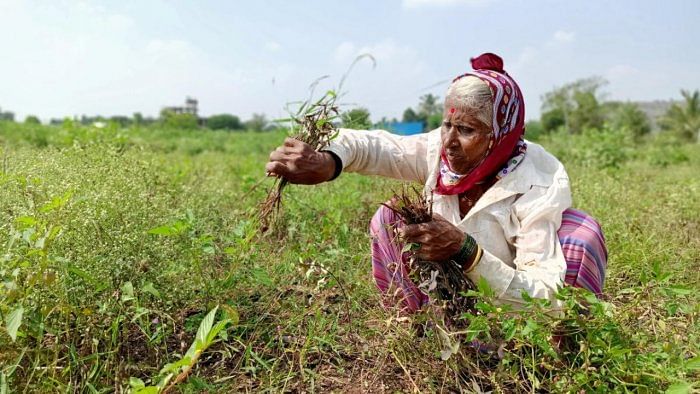
Union Finance Minister Nirmala Sitharaman presented the Union Budget 2023, which is the last full budget before the 2024 Lok Sabha election. The agriculture sector received a lukewarm response, with a modest rise in expenditure for most of the major schemes like Pradhan Mantri Fasal Bima Yojana (PMFBY), Modified Interest Subvention Scheme (MISS), Distribution of Pulses to states/UTs for welfare schemes and so on.
With the discontinuation of the Pradhan Mantri Garib Kalyan Anna Yojana (PM-GKAY), it was not surprising that the expenditure on food subsidy decreased from the actual spending of Rs 2.89 lakh crore in 2021-22 to Rs 1.97 lakh crore in the budget estimate (BE) for 2023-24.
Also, expenditure on one of the largest subsidy-fertilisers, which provides significant input support to farmers, dropped from the revised estimate (RE) of Rs 2.25 lakh crore in 2022-23 to the BE of Rs 1.75 lakh crore in 2023-24.
Having experienced a tumultuous Kharif in 2022 due to an insufficient and untimely rainfall, the least farmers in the country were expecting was a rise in the direct transfer in the form of an annual transfer of Rs 8,000 per family instead of the present Rs 6,000 under the PM-KISAN scheme.
But they were left disappointed as the allocation towards this scheme declined from Rs 66,825 crore for 2021-22 to Rs 60,000 crore in 2023-24. Unfortunately, the much-hyped ‘doubling of farmers’ income’ did not even find a place in the budget.
With a slow agricultural growth of 3.47% in the Narendra Modi period of 2014-15 to 2022-23, the dream of making more income from agriculture seems like a distant reality. To double farmers’ income from the 2015-16 level, income needed to grow at a rate of 10.4% per annum from 2015-16 to 2022-23.
But farmers’ income grew at a meagre pace of 3% per annum between 2012-13 and 2018-19, as per the latest data released by MoSPI.
With the last ray of hope dissipating, most farmers are largely dissuaded from continuing farming as a source of livelihood. So, there is an urgent need to motivate them by ensuring adequate support and sustained income.
While a direct cash transfer programme like PM-KISAN is a step in the right direction, the amount transferred may not be sufficient to support them.
To maintain a steady level of prices, Minimum Support Prices (MSP) have long been used as a policy instrument to provide output support to farmers. The impact of MSP on farmers’ income is adequately captured through Situation Assessment Survey (SAS) conducted by NSSO at regular intervals.
The NSSO’s (77th round) Situation Assessment Survey (SAS) data for 2018-19 reveals that states with effective procurement policies have higher agricultural income. It is found that most farmers in such states could sell their produce at prices higher than MSP.
For instance, around 70 % of farmers in Punjab, 73% in Haryana, and 60% in Chhattisgarh received higher prices than MSPs in these states. It was found that in 2018-19, wholesale prices of rice in harvest months in states like Punjab (Rs 2,383) and Haryana (Rs 2,908), where procurement is concentrated, were much higher than eastern states of West Bengal (Rs 1,552), Odisha (Rs 1,751) and Assam (Rs 1,562).
As a result, the average income level of agricultural households in the latter states was almost a quarter of the income of the former. Thus, it is clear that an effective price policy, with a fraction of the procurement made by the government, has the potential to uplift wholesale prices and positively impact farmers’ income.
Another important aspect of boosting farmers’ income concerns creating a conducive environment to reduce farmers’ dependency on the monocropping of paddy and wheat by helping them diversify towards other grains and oilseeds.
For this, there is a need to start a dedicated crop diversification policy under which farmers should receive support for the procurement of key inputs and an assured market for their produce.
Such an initiative will not only address farmers’ income woes but also ensure sustainable agriculture practices and minimal depletion of natural resources like water, etc. It is well known that paddy is a water-guzzling crop, leading to a massive decline in the water table in the north-western parts of India.
Promotion of pulses and edible oil through diversification will also reduce the country’s reliance on imports, saving large foreign exchange resources.
It was hoped that this budget would renew attention on farmers’ income through concerted policies and adequate allocations. The reduced expenditure on major schemes like PM-GKAY could be utilised to expand procurement and crop diversification policies.
Other focus areas on improvement in infrastructure by bringing larger areas under assured irrigation, large-scale promotion of natural farming, improving spending on agricultural research and development could bring about a turnaround in the not-so-well situation of the vast majority of farmers in the country.
The potential of the agriculture sector in uplifting the country’s economic growth must not be undermined as it continues to engage a large population.
(Roy is a Research Fellow with ICRIER and Terway is an agri-policy analyst and founder of Tuvai Nature Private Limited. The views expressed are authors’ own)